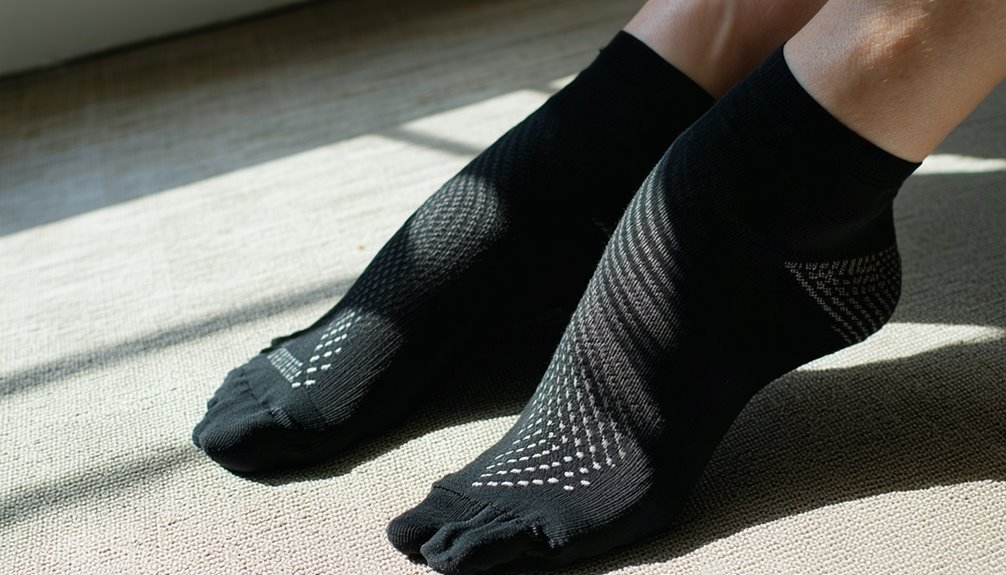Can You Wear Compression Socks All Day?
Wearing compression socks all day can be both safe and beneficial if you select the correct compression level and guarantee a proper fit. They facilitate enhanced circulation and reduce the risk of venous disorders. It's important to monitor for signs of discomfort, such as skin irritation or numbness, and make adjustments if needed. Consulting a healthcare provider for guidance can enhance your experience. There's more to understand about guaranteeing comfort and maximizing benefits throughout your day.
Understanding Compression Socks and How They Work

Although often overlooked, understanding how compression socks work is vital for maximizing their benefits. Compression socks are designed with specific materials, such as elastic fibers, to create graduated pressure on your legs. This pressure assists venous return, helping blood flow more efficiently back to your heart. When choosing compression socks, consider the materials; some offer moisture-wicking properties for added comfort and hygiene.
Different compression sock styles cater to various needs and preferences, ranging from knee-high to full-length options. It's important to select a style that provides adequate support for your activity level and medical needs. By understanding the composition and design of compression socks, you guarantee a safer, more effective usage, optimizing your health and comfort throughout the day.
The Benefits of Wearing Compression Socks
When you incorporate compression socks into your daily routine, you'll quickly notice their numerous health benefits. These specialized garments are designed to enhance circulation improvement, which can effectively reduce the risk of venous disorders such as deep vein thrombosis. By applying graduated pressure to your lower extremities, compression socks promote venous return, ensuring that blood flows efficiently back to your heart. This process not only reduces leg swelling and fatigue but also helps in the prevention of varicose veins. For individuals on their feet for extended periods, wearing compression socks can alleviate discomfort by maintaining ideal blood flow. Additionally, these socks can support muscle recovery post-exercise by minimizing lactic acid buildup. Embrace the safety and comfort that compression socks provide to sustain your vascular health.
Who Can Benefit From Compression Socks
Whether you're an athlete, a traveler, or someone managing a chronic health condition, compression socks can be a valuable addition to your wellness toolkit. They're designed to enhance circulation, reduce edema, and support venous return. Individuals who may benefit include:
- Athletes: Compression socks can improve athletic performance by stabilizing muscles and enhancing blood flow, potentially reducing recovery time.
- Pregnant individuals: Wearing these socks may alleviate discomfort and swelling associated with pregnancy health, promoting safer circulation.
- Frequent travelers: Prolonged sitting during travel can increase the risk of deep vein thrombosis; compression socks help mitigate this risk.
- Chronic illness patients: Conditions like chronic venous insufficiency can be managed with the consistent use of compression therapy.
Incorporating compression socks may enhance your health and safety.
Risks and Considerations of Extended Wear

While compression socks offer numerous benefits, it's important to be aware of potential risks associated with extended wear. Continuous use can lead to potential discomfort, especially if the socks are too tight or not properly fitted. Signs to watch for include skin irritation, numbness, or tingling, which may indicate compromised circulation. Extended wear without breaks may exacerbate these symptoms.
Furthermore, individuals with certain medical conditions, such as peripheral vascular disease or diabetes, should exercise caution, as improper use could worsen their condition. Ensuring the correct compression level is fundamental in preventing adverse effects. It's critical to regularly monitor skin changes and discomfort levels. If you experience persistent issues, consult a healthcare professional to evaluate and adjust your compression therapy plan.
Guidelines for Wearing Compression Socks Safely
To guarantee the safe use of compression socks, it's essential to focus on obtaining the proper fit, which can prevent complications such as impaired circulation. Evidence suggests you should adhere to recommended duration guidelines, typically wearing the socks during the day and removing them at night. By following these practices, you're prioritizing your vascular health and maximizing the benefits of compression therapy.
Proper Fit Importance
Guaranteeing a proper fit is essential when wearing compression socks, as the correct size optimizes their therapeutic benefits and minimizes potential complications. To achieve this, focus on the following guidelines:
- Proper Measurements: Accurately measure your ankle, calf, and sometimes thigh circumference. This guarantees a snug fit without excessive tightness.
- Sock Materials: Choose high-quality materials that offer elasticity and breathability, reducing the risk of skin irritation and promoting comfort.
- Compression Level: Select a compression level that matches your medical needs, as prescribed by a healthcare professional, to enhance circulation and prevent venous issues.
- Regular Monitoring: Continuously assess your skin for signs of irritation or discomfort, adjusting the fit as necessary to maintain efficacy and safety.
Following these guidelines guarantees safe and effective compression therapy.
Duration Recommendations
After securing a proper fit, understanding the appropriate duration for wearing compression socks is fundamental for maximizing their therapeutic effects. Most healthcare professionals suggest a compression duration of 8 to 10 hours daily, aligning with typical daytime activities. Wearing socks beyond this timeframe may compromise sock comfort and potentially lead to skin irritation or circulation issues. It's important to remove them before sleeping unless advised by a medical professional. Patients should monitor their legs for signs of discomfort, such as numbness or tingling. If these occur, it's necessary to reassess sock fit and duration. Consulting with a healthcare provider guarantees individualized recommendations and enhances safety. Remember, achieving ideal benefits relies on balancing compression duration with sock comfort.
Choosing the Right Compression Level for You
How do you determine the right compression level for your needs? Start by understanding the various compression levels, which range from mild (15-20 mmHg) to extra firm (40-50 mmHg). These levels address different medical conditions and personal comfort. Accurate measuring techniques are essential to guarantee ideal efficacy and safety. Here's how:
- Consult a healthcare provider: Discuss your symptoms and get recommendations based on your medical history.
- Measure your leg circumference: Use a tape measure at key points like the ankle, calf, and thigh.
- Evaluate your daily routine: Consider how long you'll be wearing them and during what activities.
- Trial and feedback: Begin with a lower level and evaluate comfort and effectiveness, adjusting as necessary.
Prioritize safety and consult professionals for guidance.
How to Properly Wear and Care for Compression Socks
Once you've selected the ideal compression level, it's important to understand how to wear and care for your compression socks effectively to maximize their benefits. Start by donning them in the morning when leg swelling is minimal. Roll the socks to the heel, slip them on, and unroll over the leg to guarantee even compression.
For proper care, adhere to specific care instructions: hand wash or machine wash on a gentle cycle using mild detergent. Avoid bleach and fabric softeners, which can degrade the fabric. Employ these cleaning tips: air dry your socks away from heat sources to maintain elasticity and function. Rotate multiple pairs to extend their lifespan. By following these guidelines, you'll guarantee ideal safety and efficacy in your compression therapy.
Situations Where Compression Socks Are Especially Helpful

Compression socks can be invaluable in managing a range of medical conditions and everyday scenarios. They're particularly beneficial in situations demanding prolonged standing or inactivity, where venous return is compromised. Here are some specific instances where you'll find compression socks especially helpful:
- Traveling Tips: Long flights or drives can increase the risk of deep vein thrombosis (DVT); compression socks enhance circulation.
- Exercise Routines: Post-exercise recovery is improved by reducing muscle soreness and swelling through enhanced blood flow.
- Pregnancy: During pregnancy, the risk of varicose veins and edema is elevated; compression socks mitigate these symptoms effectively.
- Chronic Venous Insufficiency: If you have this condition, compression socks support venous function, alleviating leg discomfort and swelling.
Utilizing these socks guarantees you maintain peak circulatory health in diverse situations.
Common Misconceptions About Compression Socks
While compression socks offer numerous benefits in various scenarios, there's still a lot of misinformation surrounding their usage. One common misconception is that they are solely for medical patients. In reality, their misunderstood benefits extend to athletes, travelers, and those standing all day. Compression socks help improve circulation, reduce swelling, and prevent venous disorders. Another myth is that they lack style and are only available in dull colors. However, recent advancements have introduced a variety of fashionable options, allowing you to reflect on their fashion implications without sacrificing therapeutic advantages. Some also believe wearing them for extended periods is harmful. Contrary to this, evidence suggests they can be worn safely all day, but it is crucial to select the correct compression level suited to your needs.
Frequently Asked Questions
Can Compression Socks Be Worn Overnight While Sleeping?
Jumpin' Jehoshaphat! You can wear compression socks overnight, but it's a double-edged sword. The health benefits include improved circulation, but potential risks involve skin irritation. Always consult your healthcare provider to guarantee safety and maximum benefit.
Do Compression Socks Help With Travel-Related Swelling?
Yes, you'll find compression socks enhance travel comfort by improving blood circulation. They're designed to reduce travel-related swelling, ensuring you maintain ideal vascular health during long journeys. Always consult a healthcare professional for personalized advice.
Are There Fashion-Forward Options for Compression Socks?
In today's groovy era, you don't have to sacrifice style for health. Compression socks now feature trendy designs and stylish patterns. These options guarantee you maintain circulatory support while staying fashionable, prioritizing your well-being and safety.
How Often Should Compression Socks Be Replaced?
You'll want to follow a replacement schedule for compression socks to maintain their effectiveness. Generally, sock longevity is around 3-6 months, depending on usage and care. Consistent replacement guarantees ideal support and minimizes potential health risks.
Can Compression Socks Be Worn During Exercise or Sports?
Oh sure, wear them while bench pressing your car! Seriously, though, compression socks can enhance exercise performance by improving circulation. Just make sure they fit correctly to avoid discomfort and maximize compression benefits safely during your workout.







